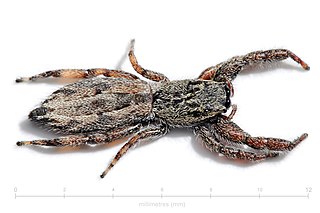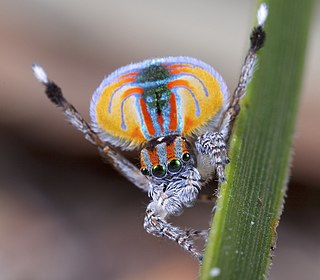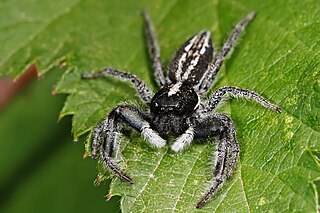Adoxotoma is a genus of South Pacific jumping spiders that was first described by Eugène Louis Simon in 1909.

Afraflacilla is a genus of the spider family Salticidae. Most species are distributed in Eastern to Northern Africa and Australia, with one species found in Europe. This genus was for a time included in the genus Pseudicius, and the boundaries between both genera are disputed. In 2016 Jerzy Prószyński erected the genus Psenuc for some borderline species. The name Afraflacilla is combined from Africa, where most earlier described species were found, and FlacillaSimon, 1901, an obsolete salticid genus now called FlacillulaStrand, 1932. This genus name is in turn derived from Aelia Flaccilla, wife of Roman Emperor Theodosius I. Afraflacilla, Pseudicius, Festucula and Marchena are close relatives and form a monophyletic group.

Cytaea is a genus of spiders in the family Salticidae.

Diolenius is a genus of jumping spiders that was first described by Tamerlan Thorell in 1870.

Hasarius is a spider genus of the family Salticidae.

Holoplatys is a genus of the spider family Salticidae.
Jacksonoides is a spider genus of the jumping spider family, Salticidae.

Maratus is a spider genus of the family Salticidae. These spiders are commonly referred to as peacock spiders due to the males' colorful and usually iridescent patterns on the upper surface of the abdomen often enhanced with lateral flaps or bristles, which they display during courtship. Females lack these bright colors, being cryptic in appearance. In at least one species, Maratus vespertilio, the expansion of the flaps also occurs during ritualised contests between males. The male display and courtship dance are complex, involving visual and vibratory signals.

Ocrisiona is a genus of jumping spiders that was first described by Eugène Louis Simon in 1901. O. frenata from Hong Kong belongs to a different, unspecified genus, according to Marek Żabka (1990). Eugene Simon places the genus Ocrisiona close to Holoplatys.

Opisthoncus is a genus of South Pacific jumping spiders that was first described by Ludwig Carl Christian Koch in 1880. There are still many Australian species that have not yet been described.
Paraplatoides is a genus of South Pacific jumping spiders that was first described by Marek Michał Żabka in 1992.
Sondra is a genus of Australian jumping spiders that was first described by F. R. Wanless in 1988.
Tauala is a genus of jumping spiders that was first described by F. R. Wanless in 1988. The name "Tauala" is an arbitrary combination of letters.
Thorelliola is a genus of jumping spiders that was first described by Embrik Strand in 1942. It is named after arachnologist Tamerlan Thorell.

Trite is a genus of jumping spiders first described by Eugène Simon in 1885. Most of the 18 described species occur in Australia and New Zealand, with several spread over islands of Oceania, one species even reaching Rapa in French Polynesia.

Zenodorus is a genus of the jumping spiders distributed from the Moluccas to Australia, including several islands of the Pacific. It was once considered a junior synonym of Omoedus, but this was later rejected by Jerzy Prószyński in 2017. At least one species, Z. orbiculatus, specializes on hunting ants.

Ohilimia is a spider genus of the jumping spider family, Salticidae.

Arkyidae is a family of araneomorph spiders first described by Ludwig Carl Christian Koch in 1872 as a subfamily of Araneidae, and later elevated to a full family in 2017.

Nanometa is a genus of long-jawed orb-weavers containing the fifteen species. It was erected by Eugène Louis Simon based on the type specimen of Nanometa gentilis found in 1908. It is included in a clade of its own defined by nine morphological synapomorphies, along with the genus Orsinome.
Barbara Maria Patoleta is a Polish arachnologist who specialises in the taxonomy, evolution and zoogeography of jumping spiders in the Pacific Islands.













